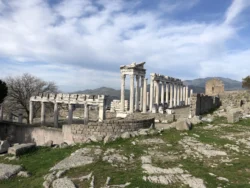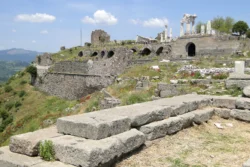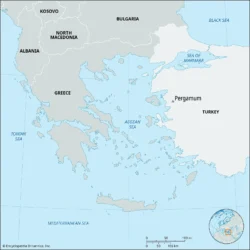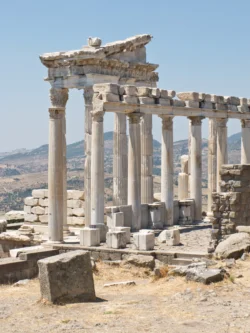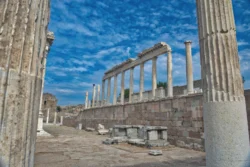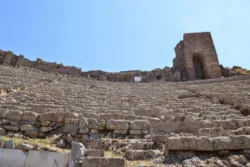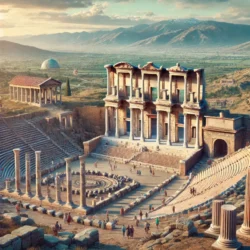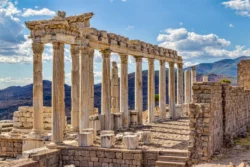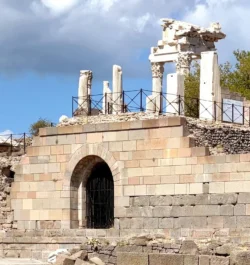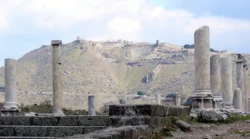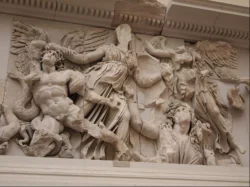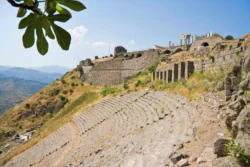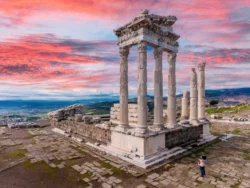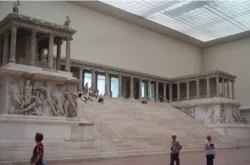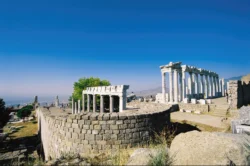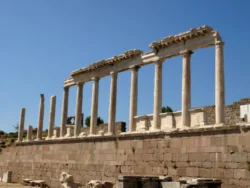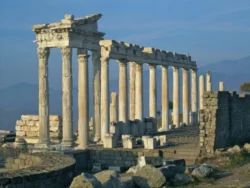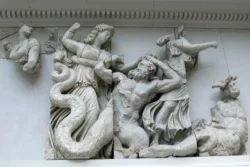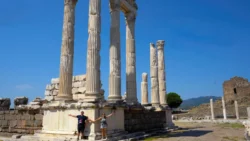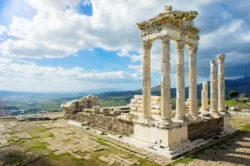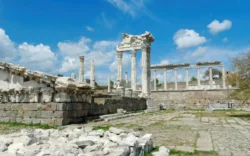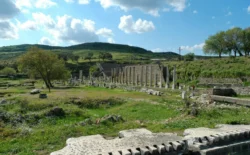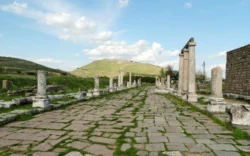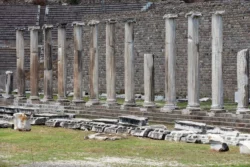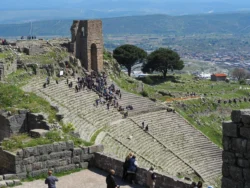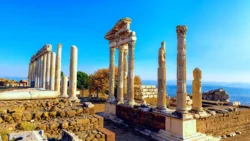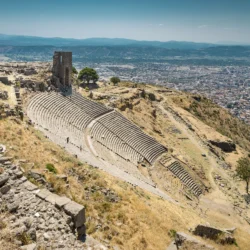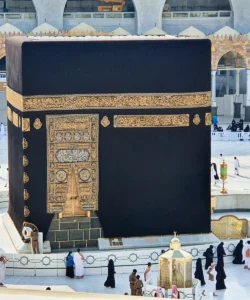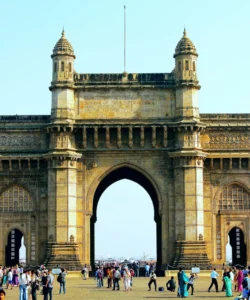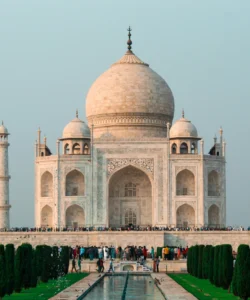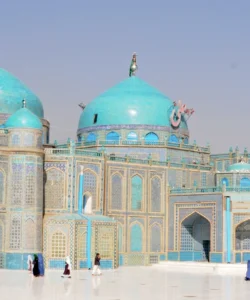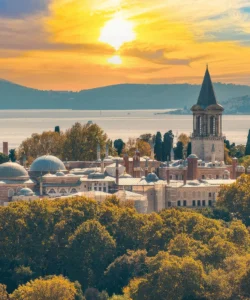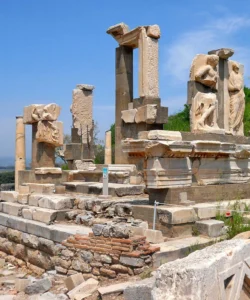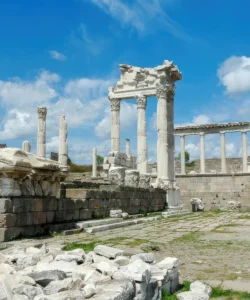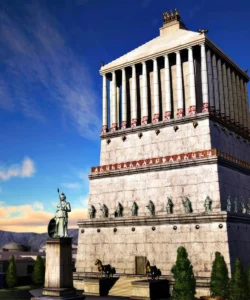Pergamum (also known as Pergamon) was a rich and powerful ancient Greek city in Aeolis, located on a promontory 26 kilometers (16 miles) from the modern coastline of the Aegean Sea, northwest of the modern city of Bergama, Turkey. During the Hellenistic period, it served as the capital of the Kingdom of Pergamon (281–133 BCE) under the Attalid dynasty, becoming one of the major cultural centers of the Greek world. It is renowned for its monumental architecture, significant library, and its association with early Christianity.
Listen to an introduction about Pergamum
Name and Address
- Name: Pergamum (Ancient Greek: Πέργαμον; Turkish: Bergama)
- Address: The archaeological site is located in Ulu Cami Mahallesi, Bergama/İzmir, Türkiye.
How to Get There
Pergamum is located near the modern city of Bergama, making it a popular and accessible archaeological site in Turkey.
- By Air: The closest major airport is Izmir Adnan Menderes Airport (ADB), approximately 2.5 hours’ drive away. From the airport, you can rent a car, take a taxi, or use shuttle services to reach Bergama.
- By Road: Bergama is well-connected by intercity buses from major Turkish cities like Izmir. Once in Bergama, local taxis or walking are options to reach the various archaeological sites, including the Acropolis, Asclepieion, and Red Basilica. The Acropolis is on a hill overlooking the city.
- On-Site: The ancient city is spread across different areas, including the Acropolis (upper city), the lower city, and the Asclepieion (healing center). Exploring the Acropolis involves significant walking on steep terrain. Comfortable shoes, water, and sun protection are highly recommended. The site is generally open daily.
Landscape and Architecture
Pergamum’s architecture is a remarkable example of Hellenistic urban planning, skillfully integrated into the steep, terraced topography of its acropolis. Many of its grand monuments and structures are still visible today, though some significant artifacts, like the Pergamon Altar, are housed in museums abroad. Pergamum was inscribed on the UNESCO World Heritage List in 2014.
- Acropolis: The city is centered on a 335-meter-high mesa, forming its acropolis. The urban planning here is a masterpiece of Hellenistic and Roman design, with palaces, temples, arsenals, and social structures built on man-made terraces.
- Pergamon Altar (Great Altar of Zeus): A monumental construction built during the reign of King Eumenes II (2nd century BCE). While the original altar’s friezes depicting the Gigantomachy (battle between Giants and Olympian gods) are largely in the Pergamon Museum in Berlin, the foundations remain at the site. It was renowned for its dramatic, high-relief sculptures and monumental scale.
- Theater: One of the steepest Hellenistic theaters in the ancient world, built into the hillside with a 70-degree angle and a capacity of around 10,000 spectators.
- Library of Pergamon: One of the most important libraries of the ancient world, rivaling that of Alexandria, said to have contained over 200,000 scrolls. Its remains are located near the Temple of Athena.
- Temple of Trajan: A grand Roman temple dedicated to Emperor Trajan and Hadrian, supported by impressive vaults beneath, showcasing advanced engineering for the steep terrain.
- Temple of Athena: Pergamon’s oldest temple, a sanctuary from the 4th century BCE.
- Asclepieion: Located outside the city limits, this was a famous healing sanctuary dedicated to the god Asclepius. It was a significant medical center, where treatments included thermal waters, mud baths, and even dream interpretation. It features a Roman theater, stoas, and a sacred way.
- Red Basilica (Temple of Serapis): A massive Roman-era temple built of red brick, originally dedicated to the Egyptian god Serapis. It was later converted into a church and is one of the Seven Churches of Asia mentioned in the Book of Revelation. One of its towers is still used as a mosque today.
- Materials: White marble was extensively used for its monumental buildings, contributing to their splendor.
What Makes It Famous
- Cultural and Intellectual Center: Under the Attalid dynasty, Pergamum became a leading center for science, art, literature, and education in the Greek world, attracting intellectuals and artists.
- Pergamon Altar: Its monumental altar, with its dramatic Gigantomachy frieze, was a pinnacle of Hellenistic sculpture and became a symbol of the city’s artistic prowess.
- Library of Pergamon: Its vast library was one of the largest and most significant in antiquity, contributing to its reputation as a hub of knowledge.
- Origin of Parchment: While not invented there, Pergamum became renowned for its mass production of parchment (derived from the Latin pergamenum, referencing Pergamum), an alternative writing material to papyrus.
- Biblical Significance: Pergamum is one of the Seven Churches of Asia mentioned in the New Testament Book of Revelation, famously referred to as the place “where Satan has his throne,” a reference often interpreted as the great Altar of Zeus or the city’s strong imperial cult.
- Medical Center: The Asclepieion was one of the most famous healing sanctuaries in the ancient world, attracting pilgrims seeking medical treatments and known for its contributions to ancient medicine, notably through the physician Galen, who was born there.
Differences from Some Other Wonders
- Integration with Topography: Pergamum uniquely stands out for its masterful integration of monumental architecture with its challenging, steep hillside topography, creating a visually dramatic and well-planned urban landscape. This contrasts with cities built on flatter plains or with less emphasis on terraced construction.
- Focus on Intellectual and Healing Arts: While many ancient cities were known for their military might or religious devotion, Pergamum’s fame is strongly tied to its intellectual pursuits (library) and its advanced medical practices (Asclepieion), giving it a distinct character among ancient wonders.
- “Satan’s Throne” Reference: Its specific mention in the Book of Revelation with the controversial “Satan’s throne” epithet gives Pergamum a unique layer of biblical infamy and symbolism not typically associated with other ancient wonders.
- Extensive Artifact Transfer: Similar to Babylon’s Ishtar Gate, a significant portion of Pergamum’s most famous architectural and sculptural elements (the Pergamon Altar) are displayed in a museum in Berlin, rather than at the original site, which is a common but notable difference from wonders that remain largely in situ.
- Parchment Production: Its role in the widespread production and popularization of parchment as a writing material is a unique historical and cultural contribution that sets it apart.
Pergamum Photos:

